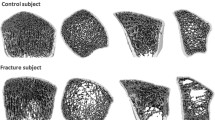Abstract
Summary
For quantitative computed tomography (QCT), most relevant variables to discriminate hip fractures were determined. A multivariate analysis showed that trabecular bone mineral density (BMD) of the trochanter with “cortical” thickness of the neck provided better fracture discrimination than total hip integral BMD. A slice-by-slice analysis of the neck or the inclusion of strength-based parameters did not improve fracture discrimination.
Introduction
For QCT of the proximal femur, a large variety of analysis parameters describing bone mineral density, geometry, or strength has been considered. However, in each given study, generally just a small subset was used. The aim of this study was to start with a comprehensive set and then select a best subset of QCT parameters for discrimination of subjects with and without acute osteoporotic hip fractures.
Methods
The analysis was performed using the population of the European Femur Fracture (EFFECT) study (Bousson et al. J Bone Min Res: Off J Am Soc Bone Min Res 26:881-893, 2011). Fifty-six female control subjects (age 73.2 ± 9.3 years) were compared with 46 female patients (age 80.9 ± 11.1 years) with acute hip fractures. The QCT analysis software MIAF-Femur was used to virtually dissect the proximal femur and analyze more than 1000 parameters, predominantly in the femoral neck. A multivariate best-subset analysis was used to extract the parameters best discriminating hip fractures. All results were adjusted for age, height, and weight differences between the two groups.
Results
For the discrimination of all proximal hip fractures as well as for cervical fractures alone, the measurement of neck parameters suffices (area under the curve (AUC) = 0.84). Parameters characterizing bone strength are discriminators of hip fractures; however, in multivariate models, only “cortical” cross-sectional area in the neck center remained as a significant contributor. The combination of one BMD parameter, trabecular BMD of the trochanter, and one geometry parameter, “cortical” thickness of the neck discriminated hip fracture with an AUC value of 0.83 which was significantly better than 0.77 for total femur BMD alone. A comprehensive slice-based analysis of the neck along its axis did not significantly improve hip fracture discrimination.
Conclusions
If QCT of the hip is performed, the analysis should include neck and trochanter. In particular, for fractures of any type, a comprehensive slice-based analysis of the neck along its axis did not significantly improve hip fracture discrimination nor did the inclusion of strength-related parameters other than “cortical” area or thickness. One BMD and one geometry parameter, in this study, the combination of trabecular BMD of the trochanter and of “cortical” thickness of the neck resulted in significant hip fracture discrimination.


Similar content being viewed by others
References
Bousson VD, Adams J, Engelke K, Aout M, Cohen-Solal M, Bergot C, Haguenauer D, Goldberg D, Champion K, Aksouh R, Vicaut E, Laredo JD (2011) In vivo discrimination of hip fracture with quantitative computed tomography: results from the prospective European Femur Fracture Study (EFFECT). J Bone Min Res: Off J Am Soc Bone Min Res 26(4):881–893. doi:10.1002/jbmr.270
Engelke K, Libanati C, Fuerst T, Zysset P, Genant HK (2013) Advanced CT based in vivo methods for the assessment of bone density, structure, and strength. Curr Osteoporos Rep 11(3):246–255. doi:10.1007/s11914-013-0147-2
Link TM, Lang TF (2014) Axial QCT: clinical applications and new developments. J Clin Densitom: Off J Int Soc Clin Densitom 17(4):438–448. doi:10.1016/j.jocd.2014.04.119
Kang Y, Engelke K, Kalender WA (2003) A new accurate and precise 3-D segmentation method for skeletal structures in volumetric CT data. IEEE Trans Med Imaging 22(5):586–598
Lang TF, Keyak JH, Heitz MW, Augat P, Lu Y, Mathur A, Genant HK (1997) Volumetric quantitative computed tomography of the proximal femur: precision and relation to bone strength. Bone 21(1):101–108
Prevrhal S, Engelke K, Kalender WA (1999) Accuracy limits for the determination of cortical width and density: the influence of object size and CT imaging parameters. Phys Med Biol 44(3):751–764
Treece GM, Gee AH (2015) Independent measurement of femoral cortical thickness and cortical bone density using clinical CT. Med Image Anal 20(1):249–264. doi:10.1016/j.media.2014.11.012
Prevrhal S, Fox JC, Shepherd JA, Genant HK (2003) Accuracy of CT-based thickness measurement of thin structures: modeling of limited spatial resolution in all three dimensions. Med Phys 30(1):1–8
Kang Y, Engelke K, Fuchs C, Kalender WA (2005) An anatomic coordinate system of the femoral neck for highly reproducible BMD measurements using 3D QCT. Comput Med Imaging Graph 29(7):533–541
Carpenter RD, Sigurdsson S, Zhao S, Lu Y, Eiriksdottir G, Sigurdsson G, Jonsson BY, Prevrhal S, Harris TB, Siggeirsdottir K, Guethnason V, Lang TF (2011) Effects of age and sex on the strength and cortical thickness of the femoral neck. Bone 48(4):741–747. doi:10.1016/j.bone.2010.12.004
DeLong ER, DeLong DM, Clarke-Pearson DL (1988) Comparing the areas under two or more correlated receiver operating characteristic curves: a nonparametric approach. Biometrics 44(3):837–845
Cheng X, Li J, Lu Y, Keyak J, Lang T (2007) Proximal femoral density and geometry measurements by quantitative computed tomography: association with hip fracture. Bone 40(1):169–174. doi:10.1016/j.bone.2006.06.018
Schwarz G (1978) Estimation of the dimension of a model. Ann Stat 6:461–465
Baudoin C, Fardellone P, Sebert JL (1993) Effect of sex and age on the ratio of cervical to trochanteric hip fracture. A meta-analysis of 16 reports on 36,451 cases. Acta Orthop Scand 64(6):647–653
Kannus P, Parkkari J, Sievanen H, Heinonen A, Vuori I, Jarvinen M (1996) Epidemiology of hip fractures. Bone 18(1 Suppl):57S–63S
Lonnroos E, Kautiainen H, Karppi P, Huusko T, Hartikainen S, Kiviranta I, Sulkava R (2006) Increased incidence of hip fractures. A population-based study in Finland. Bone 39(3):623–627. doi:10.1016/j.bone.2006.03.001
Morosano M, Masoni A, Sanchez A (2005) Incidence of hip fractures in the city of Rosario, Argentina. Osteoporos Int 16(11):1339–1344. doi:10.1007/s00198-005-1839-y
Black DM, Bouxsein ML, Marshall LM, Cummings SR, Lang TF, Cauley JA, Ensrud KE, Nielson CM, Orwoll ES (2008) Proximal femoral structure and the prediction of hip fracture in men: a large prospective study using QCT. J Bone Miner Res 23(8):1326–1333
Poole KE, Treece GM, Mayhew PM, Vaculik J, Dungl P, Horak M, Stepan JJ, Gee AH (2012) Cortical thickness mapping to identify focal osteoporosis in patients with hip fracture. PLoS One 7(6), e38466. doi:10.1371/journal.pone.0038466
Johannesdottir F, Poole KE, Reeve J, Siggeirsdottir K, Aspelund T, Mogensen B, Jonsson BY, Sigurdsson S, Harris TB, Gudnason VG, Sigurdsson G (2011) Distribution of cortical bone in the femoral neck and hip fracture: a prospective case-control analysis of 143 incident hip fractures; the AGES-REYKJAVIK study. Bone 48(6):1268–1276. doi:10.1016/j.bone.2011.03.776
Prevrhal S, Heitz M, Lowet G, Engelke K, Kalender WA (1997) Quantitative CT am proximalen Femur: In vitro-Studie. Z Med Phys 7:170–177
Yang L, Burton AC, Bradburn M, Nielson CM, Orwoll ES, Eastell R (2012) Distribution of bone density in the proximal femur and its association with hip fracture risk in older men: the MrOS study. J Bone Miner Res 27(11):2314–2324. doi:10.1002/jbmr.1693
Yang L, Udall WJ, McCloskey EV, Eastell R (2014) Distribution of bone density and cortical thickness in the proximal femur and their association with hip fracture in postmenopausal women: a quantitative computed tomography study. Osteoporos Int 25(1):251–263. doi:10.1007/s00198-013-2401-y
Peterson LE, Coleman MA (2008) Machine learning-based receiver operating characteristic (ROC) curves for crisp and fuzzy classification of DNA microarrays in cancer research. Int J Approx Reason: Off Publ N Am Fuzzy Inf Proc Soc 47(1):17–36. doi:10.1016/j.ijar.2007.03.006
Acknowledgments
Data collection of this project was supported by the EU, contract number: QLK6-CT-2002-02440-3DQCT. Statistical data analysis of this project was partly supported by the German Federal Ministry of Education and Research (BMBF, BioAsset 01EC1005D). Preliminary data have been presented at the 15 International Bone Densitometry Workshop, Breckenridge, Colorado 2012.
Conflicts of interest
None
Author information
Authors and Affiliations
Corresponding author
Electronic supplementary material
Below is the link to the electronic supplementary material.
ESM 1
(DOCX 51 kb)
Rights and permissions
About this article
Cite this article
Museyko, O., Bousson, V., Adams, J. et al. QCT of the proximal femur—which parameters should be measured to discriminate hip fracture?. Osteoporos Int 27, 1137–1147 (2016). https://doi.org/10.1007/s00198-015-3324-6
Received:
Accepted:
Published:
Issue Date:
DOI: https://doi.org/10.1007/s00198-015-3324-6




